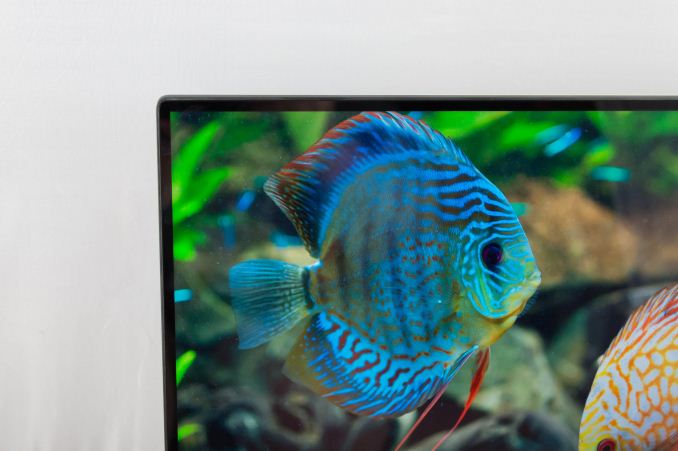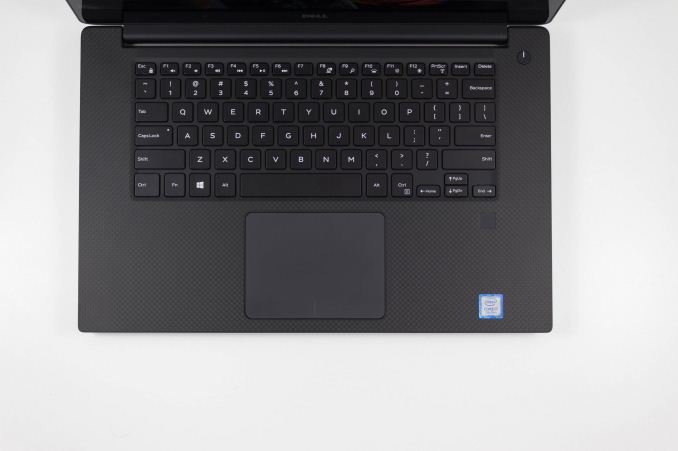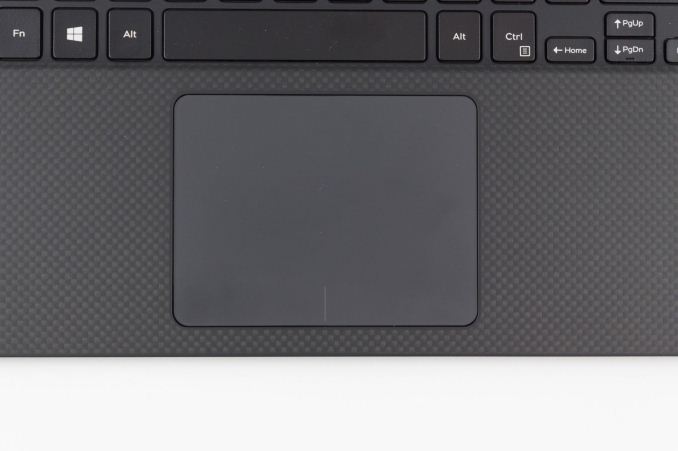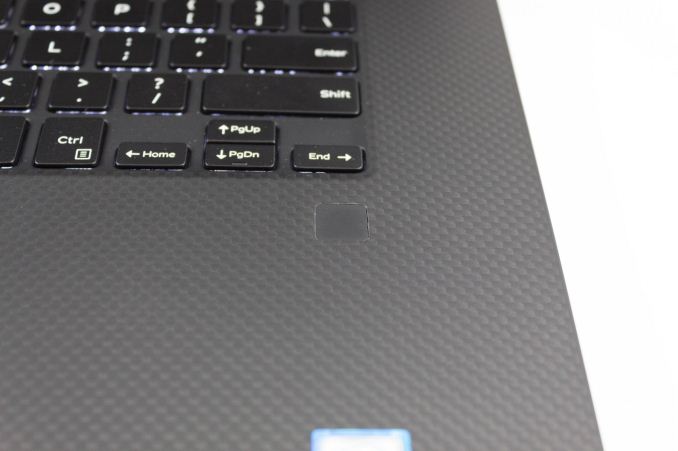The Dell XPS 15 9560 Review: Infinity Edge Part Two
by Brett Howse on July 31, 2017 8:00 AM ESTDesign
Dell already had one of the best designs for a notebook with the XPS 15 9550, so it is perhaps not a huge surprise to see them evolve that design only slightly for this year. It keeps the same thin-bezel design that has catapulted the XPS lineup into the distinctive look and feel they are known for today. Although the XPS 13 is more impacted by the thin bezels in percentage shrunk, Dell still offers the smallest 15.6-inch notebook around with the XPS 15.
Dell uses a machined aluminum top and bottom, and sandwiched in the middle is a carbon-fibre keyboard deck with a soft-touch coating. It makes the laptop very easy to use for extended periods of time, without the sharp edges that some all-metal laptops suffer from, but the coating can be a bit of a fingerprint magnet.
The keyboard is backlit in white, with multiple levels of brightness. It features a six row keyboard too, and without the extra width allowed by wider bezels, Dell doesn’t try to squeeze in a number pad, which is the right decision. Even on larger 15.6-inch laptops, that can make for a pretty cramped keyboard experience, with oddly placed keys. The XPS 15 features a fairly typical keyboard arrangement, with perhaps only the half-height arrow keys being a concern for some typists, although they are well spaced and shouldn’t pose much of an issue even for the pickiest of keyboard users.
The key travel itself is a bit disappointing. It features 1.3 mm of travel, which is likely due to the lack of space inside to offer a thicker keyboard. The keys don’t have the reassuring click sound either, with a more muted, mushy feel. We’ve been spoiled by some great laptop keyboards over the last couple of years, and the XPS 15 can’t reach that lofty goal. As with anything, a person would get used to it over time, but there are better keyboards out there.
The trackpad is smooth, and generously sized. The width is much more traditional than some devices which have gone with the ultra-wide trackpads, and because of this it feels more natural. There’s less hitting your palms on the trackpad too.
New to the XPS 15 9560, and tucked over on the right side of the keyboard deck, is a capacitive fingerprint reader. With Windows Hello integration, this gives you the option of using biometrics as a logon choice. The fingerprint reader is very responsive and has almost never missed a finger in the time here. Some people prefer the tactile feel of a fingerprint reader over a facial-recognition login method, but regardless, it’s nice to have at least one Windows Hello biometric option to speed up login.
The right side features the SD card reader, USB 3.0 with PowerShare, and a battery gauge indicator. The left side has the charging port, another USB 3.0 with PowerShare, full sized HDMI 1.4, a headset jack, and the Thunderbolt 3 connector. Other laptops may have more USB ports, but two A ports are generally enough for most people, and those that need more can easily tap into the USB-C port for far more bandwidth if necessary.
It's hard to say more about the XPS lineup at this point, since it’s become such a well-known design in the last couple of years. If you’ve not had a chance to see one in person, it’s probably worth a look. The smaller bezels really do reduce the bulk of the notebook, with the one downside in Dell’s case of a poorly positioned webcam at the bottom of the display. Dell wants to keep the top and side bezels the same size for aesthetics, and heavy webcam users will not appreciate this, with a less than flattering up-the-nose result. Since the launch of the Infinity Display, other manufacturers have done thin bezels, but with a thicker top bezel to allow space for the webcam. Not everyone uses the built-in webcam though, so whether this is an issue to anyone will be up to them.
Regardless, the XPS 15 is still one of the most striking large form factor laptops around, and Dell has managed to make it a compact device without lowering it to Ultrabook levels of performance.
















82 Comments
View All Comments
Vatharian - Monday, July 31, 2017 - link
You know that this particular Killer is stock Atheros?Vatharian - Monday, July 31, 2017 - link
Don't worry, the this Killer AC is stock Atheros Q6147A, it's actually pretty good and capable network card. They certainly do not have means to develop new AC chipset from scratch. I had my reservations, but after extensive tests I conducted at work, the chipset beat Intel AC in nearly every category, except power draw.Notmyusualid - Wednesday, August 2, 2017 - link
Ladies - all this 'Killer hate' has to stop.I've been using them for years, and yes I had tons of issues. But you simply load the original Qualcomm driver, and they are just fine - if not wonderful.
I even think the Qualcomm part has better receiver sensitivity too...
Laxaa - Monday, July 31, 2017 - link
Have you encountered any issues with your 9560. It seems like QC might be a bit over the place, as far as I've read.coolhardware - Monday, July 31, 2017 - link
Would be interested to know this as well. Dell seems to be slipping the QC arena.Garrett S. - Monday, July 31, 2017 - link
Laxaa,I just sent off laptop number 3 today. I haven't had one Dell XPS 15 9560 work as of yet. All were BRAND NEW, factory sealed from Dell. All had the same problem, where the screen would flicker on and off randomly like a strobe light in a dance club. Both brand new factory sealed units did this.
So, I ordered a 3rd laptop that was Dell manufacturer refurbished. Again, after a couple of hours of usage, the laptop screen started flashing/blinking rapidly on/off, randomly, sporadically. Honestly, it was like a strobe light at a club.
Garrett S. - Monday, July 31, 2017 - link
Laxaa, check out my verified purchase on Amazon (look under customer videos/pictures). My Dell XPS 15 9560 laptop review with 4k screen is a verified purchase and not a random review... (Verified Purchase means amazon is acknowledging that a human ordered the actual product, and it's not a random review).I posted videos of the strobe like effect that all 3 laptop screens have displayed. Here goes laptop number 4, 5, 6, etc...
How is everyone else ordering them? Brand new factory sealed are terrible from dell, and so are manufacturer dell refurbished. Is everyone ordering them from Vladimir in the alley, late at night, used?
TraderGary - Wednesday, August 2, 2017 - link
Got mine a month ago at the Microsoft Store in Atlanta.4K screen, 32 GB RAM, 1 Terabyte SSD, Fingerprint reader.
It was factory sealed.
Microsoft has Dell manufacture a Microsoft Signature Edition.
Only Windows 10 is installed with necessary drivers and Dell utilities.
This means a clean installation with no bloatware!
Added 4 years of Microsoft Complete warranty including accidental damage.
Any needed replacements are done immediately from new in-store stock.
Unboxed and set it up in the store immediately after purchase.
Immediately did all the updates.
No screen flicker.
No bad screen pixels.
No screen bleed.
DaVinci Resolve Studio 4K H.264 real-time video editing is smooth with zero dropped frames.
So far mine has been literally perfect and I'm more than pleased.
nfriedly - Wednesday, August 2, 2017 - link
Garret S: That sounds like it must be an environmental problem - something going on with your power lines or some kind of wireless interference; something like that. Have you tried any of them in a different location (e.g. go work at a library or a starbucks or whatever for a few hours)?Just running on battery can eliminate any potential issues from the AC lines.
quicksilver17 - Thursday, August 3, 2017 - link
I had the same issue. The screen would start flickering like crazy after a couple of hours of usage. However, updating to the latest Intel display driver sorted it out for me. Its been a almost a month now and there has been no flickering